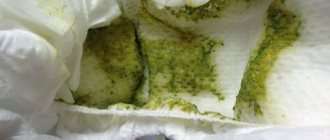Everyone knows that fruits and vegetables are very beneficial for the human body. Tomatoes should be singled out from the general list of these products. They have a large number of useful substances, minerals and trace elements that have a beneficial effect on human health. For example, tomatoes contain a substance called lycopene. It is a natural antioxidant that stops the processes of nervous excitation and inhibits the occurrence and development of cancer. Knowing and taking into account all the benefits, few people wonder why tomatoes can cause diarrhea or vomiting.
How does tomato poisoning occur?
During the process of growth, ripening, harvesting, transportation and storage, tomatoes can become contaminated with pathogenic microorganisms. If the vegetable is not washed well before eating, microbes get inside, where they produce toxins that cause inflammation in the mucous membranes of the stomach and intestines. Clinically, this is manifested by gastroenteric syndrome.
Another cause of tomato poisoning can be heavy metal salts. They accumulate in plants when they are grown along busy roads or in environmentally unfavorable places, for example, near chemical plants. Salts of heavy metals, entering the body with tomatoes, cause damage to internal organs.
It is dangerous to eat unripe tomatoes, as they contain the poison solanine. This substance has a toxic effect on the nervous system and also causes hemolysis (destruction of red blood cells). Hemolysis products enter the renal tubules and clog them, causing kidney dysfunction.
In an effort to get a larger harvest, some unscrupulous farmers abuse mineral fertilizers. This leads to the accumulation of nitrates in tomatoes, which, once in the body, disrupt the process of tissue respiration, causing dysfunction of almost all organs and systems.
Dangerous tomatoes
Tomatoes are healthy vegetables that contain antioxidants, vitamins, minerals and fiber. It is recommended to add them to your diet daily - fresh vegetables in season, and canned ones in winter.
Is it possible to get poisoned by tomatoes? Poisoning does not occur due to the vegetables themselves, but due to microbes or substances that have accumulated in their pulp. The cause of poisoning is unscrupulous farmers, violation of storage rules or sanitary and hygienic standards.
- Use of chemicals in fertilization - nitrates, pesticides and other chemical compounds can be used to speed up ripening, increase yield and kill pests. Their concentration in vegetables should be minimal and not have a negative impact on human health, but it is unknown how many chemicals are contained in a particular vegetable. The most dangerous are early tomatoes - to speed up ripening, nitrate fertilizers are used, which accumulate in the fruits and can cause serious poisoning. Other vegetables and fruits also accumulate nitrates: watermelons, melons, potatoes. Symptoms of poisoning from cucumbers or potatoes containing nitrates are similar to those described above.
- The location of the beds near highways - if vegetables grow at a distance of less than 100 - 500 m from the highway, they accumulate heavy metal salts as they grow and mature. Their concentration can be dangerous to human health, especially if his body is weakened.
- Improper storage and transportation - on the surface of vegetables, and if they are damaged inside, they can become carriers of pathogenic microorganisms. If they are poorly processed when eaten, these microorganisms will enter the body and cause foodborne illness or an infectious disease caused by poorly washed tomatoes. Poisoning can occur if vegetables are collected or sold by people who are carriers of intestinal infections, if the rules for processing vegetables before eating them are violated.
- Early picked vegetables – green tomatoes – are poisonous. They contain solanine, a toxic substance that affects the nervous system and blood cells.
Important! Tomatoes are healthy vegetables, but not for everyone. They are not recommended for consumption in case of certain diseases of the gastrointestinal tract or allergies.
Symptoms of poisoning
The clinical picture of tomato poisoning depends on the cause of the poisoning.
Poisoning caused by tomatoes infected with pathogenic microflora is characterized by symptoms of foodborne toxic infection:
- cramping abdominal pain;
- nausea and vomiting;
- diarrhea;
- increased body temperature;
- increased feeling of thirst;
- general weakness;
- headache;
- muscle pain.
When poisoned by tomatoes with a high content of heavy metal salts (thallium, mercury, cadmium, lead), victims experience:
- flatulence;
- stomach ache;
- irritation of the mucous membranes of the oral cavity and upper respiratory tract;
- diarrhea;
- dysfunction of the liver and kidneys.
When poisoning with tomatoes containing large amounts of nitrates, the following occurs:
- nausea and vomiting;
- diarrhea, in which the stool contains blood or becomes chocolate-colored;
- cyanosis of nail beds and lips.
Solanine poisoning when eating unripe tomatoes manifests itself:
- spasmodic pain in the abdomen;
- nausea and vomiting;
- severe weakness;
- diarrhea with foul-smelling feces;
- bitterness and burning sensation in the mouth;
- dilated pupils;
- increased salivation;
- arrhythmia of pulse and breathing;
- convulsive seizures;
- disturbances of consciousness, up to coma.
First aid for tomato poisoning
For any type of tomato poisoning, you must first rinse your stomach. To do this, drink several glasses of salt water or a pale pink solution of potassium permanganate, after which they induce vomiting, irritating the root of the tongue. Repeat the procedure until the rinsing water no longer contains particles of food eaten the day before.
To reduce the absorption of poison that has managed to penetrate the intestines, the victim is given activated carbon, Smecta or any other enterosorbent to drink.
Vomiting and diarrhea lead to the body losing large amounts of water and salts, which leads to dehydration and increases general intoxication. To combat this phenomenon, victims are given a solution of Regidron, Rehydration Salt, Pedithral to drink, and if they are not available, then weak black tea or water. The liquid should be taken in small sips often, so drinking will not cause increased nausea and vomiting.
Can I eat fresh green tomatoes?
You can eat green tomatoes, because they can normalize the acid-base balance and cleanse the intestines. They can be applied in the form of slices to dilated veins - they help cope with varicose veins.
Unripe fruits can protect against serious disease. But not everyone likes the taste of fresh fruits due to the high level of acidity. Therefore, before eating them, it is better to heat them or blanch them - then the concentration of harmful substances will decrease and the taste will improve.
When is medical help needed?
Most often, tomato poisoning is mild. Symptoms are quickly relieved by first aid measures, and victims do not go to the doctor. But in some situations medical assistance is necessary:
- poisoning occurred in a child or pregnant woman;
- symptoms of poisoning persist for more than two days or intensify despite the measures taken;
- intense abdominal pain;
- excessive hypotension and weakness, up to loss of consciousness;
- decrease in the amount of urine excreted;
- convulsions.
Therapy for tomato poisoning includes correction of water-salt imbalances and detoxification. In some cases, the prescription of antibacterial drugs is indicated.
Possible consequences
Tomato poisoning is especially dangerous for children in their first years of life. Their body is very sensitive to fluid loss; dehydration can cause hypovolemic shock and acute renal failure.
After poisoning, digestive dysfunction is often observed during the period of convalescence. To restore them, you should adhere to a diet that provides mechanical and chemical sparing of the mucous membranes of the stomach and intestines. In addition, enzymatic preparations (Acidin pepsin, Festal, Mezim forte) can be prescribed.
Prevention
Preventing tomato poisoning is easy. To do this, you must follow the rules:
- Tomatoes should only be purchased from certified sellers;
- do not eat unripe tomatoes that have visible damage, or have an unpleasant or unusual taste and/or smell;
- Before eating, wash tomatoes thoroughly with running water.
Education: graduated from the Tashkent State Medical Institute with a degree in general medicine in 1991. Repeatedly took advanced training courses.
Work experience: anesthesiologist-resuscitator at a city maternity complex, resuscitator at the hemodialysis department.
The information is generalized and is provided for informational purposes. At the first signs of illness, consult a doctor. Self-medication is dangerous to health!
The first vibrator was invented in the 19th century. It was powered by a steam engine and was intended to treat female hysteria.
According to statistics, on Mondays the risk of back injuries increases by 25%, and the risk of a heart attack by 33%. Be careful.
Scientists from Oxford University conducted a series of studies in which they came to the conclusion that vegetarianism can be harmful to the human brain, as it leads to a decrease in its mass. Therefore, scientists recommend not completely excluding fish and meat from your diet.
Each person has not only unique fingerprints, but also tongue prints.
American scientists conducted experiments on mice and came to the conclusion that watermelon juice prevents the development of vascular atherosclerosis. One group of mice drank plain water, and the second group drank watermelon juice. As a result, the vessels of the second group were free of cholesterol plaques.
In 5% of patients, the antidepressant Clomipramine causes orgasm.
The liver is the heaviest organ in our body. Its average weight is 1.5 kg.
When we sneeze, our body stops working completely. Even the heart stops.
Millions of bacteria are born, live and die in our intestines. They can only be seen under high magnification, but if they were put together, they would fit in a regular coffee cup.
It was previously believed that yawning enriches the body with oxygen. However, this opinion has been refuted. Scientists have proven that yawning cools the brain and improves its performance.
Most women are able to derive more pleasure from contemplating their beautiful body in the mirror than from sex. So, women, strive to be slim.
During operation, our brain expends an amount of energy equal to a 10-watt light bulb. So the image of a light bulb above your head at the moment an interesting thought arises is not so far from the truth.
The well-known drug Viagra was originally developed for the treatment of arterial hypertension.
An educated person is less susceptible to brain diseases. Intellectual activity promotes the formation of additional tissue that compensates for the disease.
The human stomach copes well with foreign objects without medical intervention. It is known that gastric juice can even dissolve coins.
According to statistics, almost every third person has problems with blood pressure. Untreated hypertension can lead to dangerous complications.
Recipes with green tomatoes
Every year, housewives are faced with the fact that they are left with green, unripe tomatoes.
Of course, it would be a pity to throw them away. But it is not recommended to eat them raw, due to solanine, which is harmful to health. To avoid bad consequences, green tomatoes should be cooked properly. First, you need to blanch them a couple of times for a few minutes. You can also soak the tomatoes in salt water for 6 hours, changing the brine every 2 hours. Well, then cook dishes from them. And it should be noted that there are many ways to heat treat green tomatoes: pickles, marinating, stuffing, and assorted preparation. You can also prepare salads with these vegetables.
Recipes with green tomatoes:
- Green tomatoes stuffed with garlic
. First you need to properly prepare the tomatoes. So, wash it, make several cuts with a knife and stuff the garlic, thinly chopped, into them. Now put horseradish leaves, dill and parsley into sterilized jars, and then put the stuffed vegetables. Then we prepare the brine: bring water (1.5 liters) to a boil and add 1 cup of sugar, 1 heaped tablespoon of salt, 0.5 cup of 9% vinegar. This amount of liquid for pouring is designed for one 3-liter jar. Fill our tomatoes and sterilize for 10-15 minutes. Roll up, wrap and leave until cool. - Green tomatoes in tomato sauce with cinnamon
. For the preparation, we will prepare jars with a capacity of 1 liter. First, prepare the vegetables: green tomatoes and sweet bell peppers. The amount of vegetables depends on how many jars you have prepared. For filling we will prepare the following components: tomato juice - 1 l, sugar - 4 tbsp. spoons, salt - 3 teaspoons and cinnamon on the tip of a knife. Place whole tomatoes and chopped peppers in sterilized jars, then fill them with plain boiling water 2 times, and the third time with boiled water. Before rolling, you need to put 1 aspirin tablet in each jar. Wrap until cool. Eat with pleasure! - Snack "Obzhorka
" Ingredients: green tomatoes - 1 kg, garlic - 5-7 cloves, 1-2 hot peppers, vinegar 9% - 70 ml, 1 tbsp. a spoonful of salt and sugar, parsley. Cut the tomatoes into slices, and the peppers into small pieces, chop the greens finely, crush the garlic with a garlic clove. Then add all the spices and leave at room temperature for a day, remembering to close the dish with a lid. As soon as the tomatoes release their juice, put our snack in sterilized jars and put it in the refrigerator for a week. After 7 days the dish is ready. - Tomatoes "Georgian"
. For this recipe you will need 5 kg of green tomatoes. They must first be left in hot water for half an hour. In addition to tomatoes, take a bunch of parsley, cilantro, celery, dill, as well as 2 bell peppers and 1 hot pepper, a head of garlic and grind them in a blender. We cut the tomatoes and stuff them with the resulting mixture. Then we place them tightly in jars. Now let's prepare the marinade. 2 tbsp. spoons of salt, 1 teaspoon of sugar and the same amount of vinegar, bring another 1 liter of water to a boil. Sterilize the jars for 20 minutes, roll them up, and wrap them until they cool. - Green tomatoes in Korean style
. Any tomatoes are suitable for this recipe: milky green, green and brown. So, wash 1 kg of tomatoes and cut them into slices. Then wash 1 red hot pepper and cut into small pieces. Press 7 cloves of garlic with a garlic clove. Mix all ingredients and add 70 ml of 9% vinegar, 1 tbsp. a spoonful of salt and 2 tbsp. spoons of sugar. Transfer to glass jars and let them sit in the refrigerator for a whole day. Korean green tomatoes are ready. Remember that they must be very spicy, because Korean dishes are spicy. Of course, you can reduce the amount of components that give this taste. - Salad "Color Palette"
. Ingredients: green tomatoes - 4 kg, onions - 1 kg, the same amount of carrots and red bell pepper. First you need to wash the vegetables. Now let's get to cutting: tomatoes - into thin half rings, and onions, carrots and peppers - into thin strips. Place the chopped vegetables in an enamel bowl and add 0.5 cups of salt. We leave them in a sealed container in a cool place for 6 hours. Then add 1 glass of sugar, mix everything and put it in jars. We sterilize for 15 minutes, and then the already familiar procedure: roll up, wrap, leave until cooled. - Green tomato caviar
. We wash 4 kg of green tomatoes, 1 kg of onions and carrots, 0.5 kg of bell pepper. Then finely chop all the vegetables, add 0.5 cups of salt and leave overnight in a closed enamel container at room temperature. Then add 1 glass of sugar, 5 bay leaves, pepper and cloves, as well as 300 ml of vegetable oil. Cook over low heat for 1 hour, stirring while doing so. Place the caviar near the jar and roll it up. Eat for your health! - Adjika from green tomatoes
. Ingredients: green tomatoes - approximately 2 kg, bell pepper - 0.5 kg, hot pepper - 2 pieces. And what is adjika without spices? So, we need approximately 2 tbsp. spoons of vinegar, 6 cloves of garlic, 1 tbsp. a spoonful of sunflower oil, salt and khmeli-suneli seasoning to taste. Preparing this dish is not difficult. Wash and chop all the vegetables, you can use a blender or meat grinder, and crush the garlic with a garlic clove. Mix the ingredients, adding seasonings and spices. Cook for an hour. You can use adjika after cooling, or you can put it in jars for the winter. - Green tomato jam
. First, wash 1 kg of tomatoes and cut into slices so that each contains seeds. Then prepare syrup from 2 glasses of water and one and a half kg of sugar. Pour it over the prepared tomatoes and leave to soak for 3 hours. Then cook the jam for 25 minutes, remove from heat and leave for 2 hours. We repeat the procedure 3 times. About 10 minutes before the end of cooking, add the lemon, ground and peeled. Place into jars. Our jam is ready. Drink tea and enjoy the unusual taste! - Green tomato and corn soup
. Cut 1 onion and 1 clove of garlic into small pieces. Then fry them in sunflower oil until soft. Then we transfer these fried vegetables into a saucepan and add ground cumin (one and a half teaspoons), fresh corn kernels (one and a half cups), 4 green tomatoes cut into pieces. Mix everything thoroughly and let it simmer over low heat for 5 minutes. After this, pour in 7 cups of vegetable broth, add salt and pepper to taste and cook until tender. This unusual soup will be a delicious variety for your lunch! - Fried green tomatoes
. Ingredients: 4 green tomatoes, 2 eggs, 3 tbsp. spoons of sunflower oil, 1 glass of cream, 3 tbsp. spoons of flour and 4 tbsp. spoons of breadcrumbs. First, wash the tomatoes and cut them into slices 1 cm thick. Then beat the eggs with a mixer. Now we begin to fry the tomatoes. Take a slice of tomato, dip it in beaten eggs, bread it in breadcrumbs and fry in sunflower oil until golden brown. For the unusual taste of our dish we need sauce. The basis for its preparation will be the remaining butter in the frying pan, to which we will add cream and cook, stirring until the sour cream becomes thick. Then we add salt and pepper. Serve the tomatoes by first pouring the sauce over them.
Important to remember! Green tomatoes do not need to be combined with meat, fish and bread. It is recommended to take a break of 2 hours between these products.
Since green tomatoes are not a separate variety of vegetables, but unripe fruits that are used in various cuisines, interesting facts will also be associated with their red “relatives”. For a long time they thought that these vegetables should not be eaten; moreover, they were considered poisonous and ornamental plants. The first recipe for a tomato dish was written in a recipe book in Spain in 1692.
In Russia, they first learned about this vegetable in the 18th century. At that time, the fruits did not ripen completely, but remained green, so they were grown to decorate rooms and territories. Scientist A.T. Bolotov managed to grow ripe tomatoes.
Interesting facts about eating tomatoes are associated with the name of George Washington. In the 70s of the 18th century, he was the commander of a rebel army during the War of Independence. His cook, J. Bailey, an agent of the King of England, was supposed to kill Washington. And believing that the tomatoes were poisonous, he served them with meat stew to the commander. The future president ate the juicy tomato with pleasure, but the cook, tormented by remorse, committed suicide.
Green tomatoes are popular not only on the table, but also in books. It is worth mentioning Feni Flagg’s novella “Fried Green Tomatoes at the Polustanok Cafe.” In this work, the reader is offered two recipes for fried green tomatoes. A film of the same name was made based on this book.
What to cook from green tomatoes - watch the video:
Green tomatoes are used in many cuisines around the world. They are especially preferred by gourmets because of the unusual taste of this unripe vegetable. Due to their beneficial properties, they are often ingredients in various dishes. They are salted, pickled, and included in salads. Of course, you can buy green tomatoes at the market, but there is a risk of purchasing vegetables with nitrates. It is much safer to eat tomatoes grown by yourself.
In the fall, when the harvest ends, most households are faced with the question of where to put the remaining green tomatoes? At this time they don’t turn too red, and there are still plenty of ripe tomatoes. But I also don’t want to throw away good fruits. Some people wonder whether they should eat green tomatoes just like red ones? Let's figure out whether this can be done.
Girls, can tomatoes cause diarrhea?
Girls, can tomatoes cause diarrhea? (in an adult)
20 comments on “Girls, can tomatoes cause diarrhea”
Maria, what is this connected with? my husband used to eat endless meals, everything was fine, now he made a salad for three days and after each meal he had diarrhea, yesterday he didn’t eat everything normally, this morning he ate one tomato and after 5 minutes he ended up in the toilet
I don’t think so.. Didn’t you eat anything other than tomatoes?
Irina, I don’t think that potatoes and fish will cause diarrhea
Julia, well, the body reacted. this happens.
Irina, maybe this happens, it happens to me too. Not always, but sometimes after fresh vegetables.
Maria, what can I give now to stop the diarrhea? need to go to work
Yulia, tomatoes shouldn’t cause diarrhea either, especially since everything was fine before. Try excluding tomatoes and observing the condition. If there is no improvement, then you need to get tested.
Julia, enterofuril or smecta.coal. almagel
Irina, I’m telling you, yesterday I didn’t eat them and everything was fine, but today I ate one and ran to the toilet
Maria, well, if the vegetables are not washed well, then it’s possible...
Irina, yes, it’s always good to wash it. But for some reason, after them, lately there’s been such an immediate result. and not always.
Maybe from the unwashed, but this has never happened before
You never know what is stuffed into these vegetables, what they were fertilized with and what they were crossed with... anything can happen!
Irina, it may well be
Well, in general, tomatoes are weakening!
Does he have problems with his pancreas and gall bladder? For such diseases, tomatoes are allowed to a minimum
My husband also immediately gets an upset stomach from tomatoes. And even from those that we grow in our garden. We don’t water or fertilize with any water. So there's nothing wrong with nitrates! Everyone in the family eats the same, but only the husband has this “effect”. Some kind of intolerance to tomatoes...
What vegetables should you avoid?
Vegetable dishes are tasty and healthy. But some of them should not be eaten if you have stool disorders:
- Beetroot for diarrhea will increase the excretion of feces, it has laxative properties, including beetroot juice;
- onions - prohibited in a raw state, allowed in boiled or baked form;
- green salad;
- fermented products - cabbage, cucumbers, beet kvass;
- raw cabbage, broccoli for diarrhea, although not prohibited, is not recommended;
- hot peppers;
- peas, beans;
- cucumbers;
- radish;
- radish;
- citrus.
Symptoms and treatment of tomato poisoning
Tomatoes are very tasty and healthy. A large number of dishes and sauces are prepared on their basis, and juices are made from them. Almost everyone knows about the benefits and rich vitamin composition of these vegetables and tries to add them to their daily diet. But not all tomatoes are healthy, and not all of them should be eaten . In this article, we looked at the reasons why tomato poisoning may develop, its clinical signs and treatment methods.
What can cause tomato poisoning?
- Treatment of tomatoes with chemicals during cultivation . These can be nitrates, pesticides, chemical fertilizers. They are used to accelerate plant growth and protect them from diseases and pests. Early tomatoes are especially dangerous; laboratory analysis usually reveals a huge amount of nitrates in them.
- Poorly washing tomatoes before eating them can cause dangerous microorganisms to enter the body.
- Cooking dishes from tomatoes by people suffering from intestinal infection. Through dirty hands they can make food contagious and dangerous . In catering establishments you can catch E. coli, salmonellosis, and dysentery.
- Eating spoiled and rotten tomatoes. If stored incorrectly or for a long time, putrefactive bacteria multiply in these vegetables, which can cause poisoning.
Remember that even high-quality and safe tomatoes can harm a person. You cannot eat them if you have some diseases of the digestive system or allergic intolerance. If after eating these vegetables you begin to notice a worsening of your condition, heartburn, stomach pain or an itchy rash, consult your doctor.
Symptoms of poisoning
- pain in the abdomen and attacks of intestinal colic. Such symptoms are provoked by flatulence and increased gas formation,
- nausea and vomiting. Vomit may contain remnants of undigested tomatoes.
- diarrhea or loose stools.
- headache and general weakness.
In case of intoxication with nitrates or pesticides, an increase in body temperature is possible . The patient experiences severe intoxication of the body. Tachycardia develops and blood pressure drops. Breathing disturbances, shortness of breath, and pale skin may occur. In severe cases, convulsions and disturbances of consciousness occur.
Please note that the severity of symptoms correlates with the amount eaten. If you really want to add potentially dangerous early tomatoes to your food, use half the vegetable for this. This amount will be enough to give the dish freshness and taste and not enough to develop acute nitrate intoxication.
What to do if you are poisoned by tomatoes
Tomato intoxication can be dangerous for the human body. Nitrates and pesticides, which can provoke it, negatively affect many internal organs and structures. When the first symptoms of tomato poisoning appear, you should call emergency medical help . Only doctors can assess the severity of the patient’s condition and carry out treatment.
Remember that you should not self-medicate and endanger the patient’s life. All the advice and recommendations read on the Internet and heard from neighbors cannot replace qualified medical care.
- Clear the gastric cavity of the remnants of low-quality tomatoes. To do this, you need to drink 3-4 glasses of plain water in one gulp and induce vomiting.
- Drink sorbents (enterosgel, activated carbon, atoxil, polysorb, etc.). The dosage of these medications is indicated in the instructions or on the packaging.
- Give the poisoned person plain or mineral water without gases.
This primary care will help reduce intoxication and dehydration . But it does not help to completely cure a person and is only the first stage on the path to recovery.
Treatment of poisoning is carried out in the infectious diseases department of the hospital. If at the time of examination by the doctor the patient’s condition is mild and stable, he can be treated at home according to the doctor’s recommendations.
- Rehydration therapy, which is aimed at replenishing the body of lost fluid and reducing the level of intoxication. If the patient vomits and cannot drink on his own, he is given droppers with solutions. If there is no vomiting, the patient is prescribed plenty of fluids. You can drink alkaline mineral water or pharmaceutical preparations for oral rehydration , for example, Rehydron.
- Antiemetic drugs (metoclopramide, cerucal). They help eliminate the urge to vomit.
- Sorbents. These drugs are prescribed in a course of 5-7 days.
- Enzymes (mezim, creon, pancreatin). They are necessary to restore digestion.
- Dietary food. It is signed by the attending doctor, who takes into account the characteristics of the patient’s condition.
Tomatoes can be dangerous and harmful to humans. They may contain nitrates and pesticides. Poisoning from such tomatoes appears within the first few hours after eating them . Patients complain of abdominal pain, vomiting and diarrhea. Treatment is carried out in a hospital setting or at home under the supervision of a doctor.
Question: What should I do if I have diarrhea in the summer from fruits and fresh vegetables?
What to do if you have diarrhea in summer from fruits and fresh vegetables?
Fresh fruits and vegetables can cause diarrhea for a number of reasons:
- The laxative effect of cucumbers, zucchini, tomatoes, cabbage, apples, plums, etc. If you consume these products in large quantities, the intestinal mucosa becomes irritated, and then may become inflamed.
- Some vegetables and berries contain too much acid - sorrel, spinach, tomatoes, red currants, etc. Large amounts of these acidic foods can also cause diarrhea.
- By consuming unwashed vegetables and fruits, you can become infected with one or another intestinal infection.
- There is also such a disease as “fruit” colitis: if the mucous membrane of the large intestine is chronically inflamed, then fresh vegetables and fruits cause an exacerbation of the disease, and, consequently, diarrhea.
To prevent fruits and vegetables from causing diarrhea, do not eat a lot of them and combine these foods with regular foods. If diarrhea does occur, stop eating greens and take one of the folk remedies - rice water, infusion of pomegranate peels, blueberry jelly, infusion of walnuts, etc. You can stop diarrhea with the help of Loperamide (Imodium).
If folk remedies do not help and diarrhea continues, you should consult a doctor. And if “summer” diarrhea is combined with an increase in temperature, a doctor should be called immediately.
Contraindications to eating vegetables
Contraindications to eating vegetables during diarrhea vary depending on the type of product and the patient's medical history. But the common ones are:
- The first day of the disease.
- Children of the first year of life.
- No improvement on day 3.
- Fever due to defecation disorder.
- Individual intolerance to the product.
- With proven laxative properties – beets.
- Fried vegetable dishes.
What to eat during diarrhea will be recommended by the attending physician based on the causes of the disease, age and medical history of the patient. Do not experiment with diet during treatment. If you have diarrhea, it is better to fast than to worsen the condition by eating cabbage or beets.
Among vegetables and fruits there are many that loosen stools - for example, cucumbers, beets and plums. Soft stools usually do not turn into diarrhea and return to normal literally on the second day. If, while eating raw food, diarrhea begins, with no end in sight, then you need to be wary. Of course, the cause of indigestion can be an acute intestinal infection caused by microbes entering the stomach. But often raw vegetables and fruits provoke an exacerbation of various chronic diseases. In this case, hoping that “fruit” or “vegetable” diarrhea will go away on its own means wasting time and triggering the disease.
Most often, stool upset after eating raw fruits and vegetables occurs with chronic inflammation of the colon - colitis. This unpleasant disease occurs in many young women. Raw vegetables and fruits consist almost entirely of coarse fiber, and the inflamed intestinal mucosa is not ready for such stress. In this situation, even one cucumber from the garden is fraught with serious trouble the next morning.
And yet there is a way out. Since the intestines themselves refuse to process coarse fiber, we need to help them with this. Grind all plant foods with a mixer until smooth and eat the puree in small portions.
When choosing berries and fruits, remember that not all of them have a laxative effect. Some, on the contrary, sharply reduce intestinal contractions - these are blueberries, bird cherry, pears and quince. And they contain no less vitamins and other useful substances than other plant-based delicacies.
If these precautions do not stop diarrhea, you will have to switch from raw fruits and vegetables to boiled ones. Just don’t forget that when cooking, the beneficial substances pass into the water. Therefore, do not pour it out - the vegetable broth is useful for preparing soups, porridges or vegetable stews. And fruits and berries make delicious compotes and fruit drinks. But it is better to steam vegetables, as they retain more vitamins.
Excessive intestinal activity can be weakened by eating viscous foods - jelly, mousse and jellies. In addition, they are appetizing to look at and very tasty. I advise you to refresh unsightly and unloved porridge with scalded pureed berries. For the first course, slimy vegetable soups are perfect.
It would be great to master the preparation of dishes such as soufflé and casserole of vegetables and fruits. Well, if you really want something sweet, then the intestines will not object to a small amount of jam, marmalade, homemade fruit marshmallows, marshmallows, baked apples and pears.
When you cope with diarrhea, you can no longer bother yourself with all sorts of culinary delights. But you should switch to raw fruits gradually and carefully, starting with freshly squeezed juices. And under no circumstances eat whole vegetables, only finely chopped and little by little - 100-150 grams per day. You cannot make salads from several vegetables and fruits - introduce them into the menu one at a time, observing the reaction of the diseased intestines.
To restore impaired digestion, you will have to switch to a diet for a while. No spicy foods. Only porridges, and those with water, and exclude millet and pearl barley. Soups should be cooked in low-fat broths. Grind boiled meat and fish, give up milk, replacing it with fermented milk products. Forget about fresh baked goods and brown bread. Replace white bread with crackers. By the way, with chronic colitis, it is harmful to eat bread with bran and wholemeal flour. Boil eggs soft-boiled or make an omelet from them. Limit salt and sugar.
If you cannot normalize your stool with diet alone, you will have to take antibiotics. Only they will destroy the pathogenic microbes that have proliferated in the intestines. White clay, starch and bismuth preparations will help minimize peristalsis and bloating. Decoctions and infusions of St. John's wort, chamomile, eucalyptus leaves and alder cones have a calming effect on the mucous membrane. You can also make microenemas with these herbs. Warm heating pads and warming compresses with alcohol, petroleum jelly and even just warm water help calm an excessively raging intestine. Warm pine baths are also useful.
Green vegetables in the diet for diarrhea: allowed and prohibited
Nutrition during diarrhea is based on foods that prevent the appearance of unpleasant symptoms and minimize them. Thus, green vegetables for diarrhea belong to a controversial group, some of which can be consumed, while others are strictly prohibited.
For the most part, everything green has a sour taste or contains a large amount of fiber. And acid and fiber negatively affect the digestive process during diarrhea.
Effect of vegetables on the body
Diarrhea occurs as a result of several reasons. One of the most common is the sudden development of pathogenic microorganisms in the stomach and intestines. The second reason is the accelerated process of removing food from the intestinal tract, often undigested. Another reason is increased mucus production. And the list ends with the reason why the absorption of liquid is disrupted; the body does not absorb it, but secretes it and removes it from the body.
Acidic green, yellow and red vegetables, including pickled foods, promote the development of pathogenic microorganisms. With diarrhea, this turns out to be a critical factor, since the balance of the flora is disturbed.
Spicy green vegetables and spices such as capsicum and garlic are very irritating to the intestines. Due to this, mucus secretion and motility increase, and the recovery process also worsens.
Another class of plant foods that have a dual effect on the body are mushrooms. This also includes vegetables with similar effects - beets and corn. They can enhance peristalsis, but they are great for diarrhea caused by excessive mucus production.
Prohibited green vegetables for diarrhea
Some classes of green vegetables are completely prohibited for consumption during diarrhea:
- Salted cucumbers. Fresh cucumbers improve peristalsis, normalize bowel movements and can be consumed in small quantities for diarrhea if it is accompanied by dehydration. The water contained in vegetables helps restore balance. Moreover, cucumbers contain iodine, phosphorus, vitamins and calcium. However, salted vegetables lead to acute diarrhea.
- Cabbage. White cabbage stimulates peristalsis and contains a lot of fiber; it is contraindicated for diarrhea. May cause fermentation and flatulence. Sauerkraut is useful in the absence of intestinal problems, but during diarrhea it can significantly worsen the patient’s condition.
- Green hot pepper. Spicy foods should not be included in the diet for diarrhea, and chili peppers are no exception. It irritates the walls of the stomach and intestines, causing bloating.
- Broccoli and cauliflower. In most cases, they increase diarrhea, as they contain a high concentration of fiber. Green salad and asparagus are also prohibited from the cruciferous family.
All varieties of green vegetables with a pungent taste, such as radishes, are excluded from the diet. They can irritate the stomach, like onions and hot peppers.
The occurrence of diarrhea from vegetables
It happens that diarrhea goes away, but literally after 1-2 weeks it returns again. Many begin to suspect the presence of some kind of disease due to relapse of the pathology. But the cause may be green vegetables, diarrhea from which develops as a result of pathogenic bacteria and product abuse.
Topping the list is the development of harmful microorganisms in pickles - a jar of cucumbers often causes diarrhea. A similar condition appears after eating fermented sauerkraut.
Important! If a person has a sensitive intestine that reacts to simple foods, then raw garlic is contraindicated for him.
Diarrhea can also appear from low-quality cucumbers purchased in the store in December-March. At this time, they contain a minimum of nutrients and a maximum of nitrates.
Recommendations for products for diarrhea
The main foods during diarrhea are vegetables, cereals and low-fat protein foods that can stop diarrhea. They have a good effect on the body, saturate and cleanse it of harmful substances. Vegetables are considered the most controversial issue. Here are some of them you can eat while treating diarrhea:
- zucchini – have a strengthening effect and are safe for diarrhea,
- eggplant is a tasty product that, when boiled or baked, helps fight pathology,
- boiled carrots and beets,
- green peas and green beans in limited quantities.
If you have severe diarrhea, the last two products should be avoided, as they belong to the legume family and often cause bloating and flatulence. You can also eat other vegetables stewed and boiled, but in limited quantities:
- green and red bell peppers,
- mashed potatoes,
- broccoli, subject to normal tolerance (may cause diarrhea in some),
- fresh cucumbers, but only from the garden, not store-bought ones,
- corn – in small quantities treats mucous diarrhea,
- pumpkin – has a strengthening effect,
- Fresh tomatoes are nutritious vegetables, which are recommended 3-4 days after passing the acute stage of diarrhea.
Fruits and berries have an even more acute effect on the irritable intestines and stomach, so the choice is significantly limited: you can eat pureed apples and bananas, as well as baked quince. The berries allowed are blueberries, chokeberries and dried bird cherry. You can make jelly and jellies from these products.
You can eat greens when you have diarrhea, but garlic and green onions - only in processed form and in limited portions. In general, all vegetables and fruits during diarrhea should be consumed boiled, stewed or baked. The only exception is fresh cucumbers.
Not all green vegetables can be dangerous if you have diarrhea. But you should be especially wary of fresh and salted vegetables during periods of acute diarrhea.
Overview of allowed vegetables
For diseases of the gastrointestinal tract accompanied by stool disorders, diet is an important component of treatment. Vegetables during this period should be present in the diet of an adult or child.
Basic principles when choosing products:
- gentle effect on the intestinal mucosa;
- do not cause fermentation or flatulence;
- do not have a laxative effect;
- do not cause a feeling of disgust or vomiting in the patient;
- must be subjected to heat treatment without compromising the nutritional content;
- all dishes must be fresh.
Cabbage
All representatives of this genus - broccoli, cauliflower, common cabbage - are a storehouse of useful substances and are rich in coarse fiber. Excessive consumption of this vegetable causes irritation of the walls of the gastrointestinal tract and excessive gas formation.
Contraindications to eating cabbage are conditions in which coarse plant fibers are prohibited. For diarrhea, representatives of this genus are not included in the list of permitted products. Sauerkraut for diarrhea, despite all its beneficial qualities, is prohibited during bowel disorders.
Pumpkin
Pumpkin is a dietary vegetable. Like cabbage, it contains plant fiber. But at the same time it does not irritate the mucous membranes of the gastrointestinal tract and does not increase gas formation. Pumpkin for diarrhea, although it improves intestinal motility, does not increase the amount of water in the stool.
Pumpkin juice is used to prevent dehydration due to diarrhea. Baked pumpkin pulp is a soft adsorbent and helps remove toxins from the body.
For diarrhea, it is recommended to eat simple dishes: mashed potatoes, stewed pumpkin, pumpkin porridge.
Potato
Potatoes are allowed for diarrhea, but only boiled and baked. Due to the high starch content, the vegetable has an astringent and enveloping effect. This helps normalize stool. In addition, this vegetable is used as a source of potassium, which the body loses during diseases of the gastrointestinal tract.
Mashed potatoes are one of the few foods that are allowed for diarrhea. But without added butter and milk. In rare cases, diarrhea gets worse after eating the puree. But this is not observed when eating boiled potatoes or soup. The cause of this condition is an allergy to potato starch. In this case, puree is prohibited.
Carrot
Carrots are rich in vitamins and plant fiber. Does not irritate the stomach and intestines. For diarrhea, this vegetable is allowed, but only in boiled or stewed form.
Carrot decoction is an effective remedy for preventing dehydration and is approved for use even for infants.
Other
What else can be included in the diet for stool disorders, besides carrots and potatoes? The list of permitted vegetables is small, but the patient will not suffer from dietary monotony:
- zucchini;
- green pea;
- green beans;
- tomatoes;
- eggplant;
- onion, garlic - a little as an addition to vegetable soup;
- parsley dill.
If, after taking this or that product, unpleasant sensations appear in the gastrointestinal tract, or a child or adult has diarrhea, this vegetable should be discarded.
Why tomatoes are insidious: list of symptoms of poisoning
Not every person, when buying tomatoes in a store out of season, thinks about the fact that they can get severe tomato poisoning, which is fraught with negative consequences for health. Tomatoes, like other foods, can be dangerous to the body. You should find out the main reasons that contribute to the occurrence of tomato poisoning and the symptoms that arise subsequently:
- Penetration of microbes into a dish with tomatoes that are on the hands or mucous membranes of a person who has an intestinal disease and took an active part in the preparation.
- A tomato, which during the growing process was treated with chemicals that protect the vegetable from pests and parasites, contains a potential poison for humans.
- If you have eaten a vegetable that has a spoiled appearance, damaged skin integrity, or a putrid odor. When such a tomato is stored for a long time, the process of proliferation of dangerous bacteria and microorganisms occurs in it.
- When growing tomatoes in places close to highways, or to enterprises that use chemicals in their production process. Chemicals can accumulate in tomatoes and then enter the human body.
- If you have eaten a tomato that has not been washed well. In this case, the risk of intoxication with nitrates, with which the vegetable was previously processed, is reduced.
Symptoms directly depend on what exactly caused the poisoning. If intoxication occurs due to the high content of heavy metals in the tomato, then the signs will be as follows:
- painful sensations in the abdomen;
- severe diarrhea;
- bloating;
- failure of the kidneys and liver.
If poisoning occurs when eating a tomato contaminated with bacteria, the disease will manifest itself as follows:
- headache;
- increased body temperature;
- cramping pain in the abdominal area;
- diarrhea;
- strong thirst;
- nausea accompanied by vomiting;
- weakness in the body;
- muscle pain.
If you have eaten tomatoes that contain excessive amounts of nitrates, the symptoms will be as follows:
- loose stools that may contain blood streaks;
- severe nausea;
- vomiting, reaching 7-10 times a day;
- blue discoloration of the lips and oral mucosa.
Frozen tomato intoxication
In addition to preparing for the winter in the form of canned food, another method of storing tomatoes has recently been used - freezing. As you know, heat treatment destroys most vitamins and minerals, but this does not happen when frozen.
Frozen tomatoes do not contain preservatives, salt or sugar added during pickling, and almost completely retain the taste and color of ripe fruits. But are they really safe? Despite all the advantages, poisoning from frozen vegetables occurs regularly.
Causes of poisoning:
- Improper storage of frozen tomatoes can cause intoxication. The temperature in the freezer should be within – 25 degrees.
- Re-freezing.
- After defrosting, the product was kept at room temperature for a long time.
Poisoning with green tomatoes, a specific reaction of the body
Eating green tomatoes is dangerous. This component of the diet should be excluded in pregnant women and children. The body can react violently to the consumption of such a product, since the poison in green tomatoes can not only have a strong effect on the spinal cord and brain, but also lead to death. The main features include:
- heart rhythm disturbance;
- acute cramping pain in the stomach and intestines;
- nausea;
- profuse vomiting;
- dilated pupils;
- convulsions;
- drowsiness;
- diarrhea accompanied by a specific unpleasant odor;
- increased sweating;
- loss of consciousness;
- coma.
What to do if you are poisoned by tomatoes
Diarrhea from tomatoes is a common symptom in an adult. If there are other alarming symptoms of poisoning, you should immediately call an ambulance, and before that, take a number of actions aimed at alleviating the condition of the victim. To do this you will need:
- Rinse the stomach of any bad tomatoes present there to stop the process of toxic substances being absorbed into the bloodstream. To do this, collect one and a half to two liters of clean water at room temperature. Dissolve several granules of potassium permanganate in water. Drink all the water in two sittings. If there is food in the vomit, rinse the stomach again in the same way.
- After washing, give the poisoned person a sorbent drug. These are polysorb, activated carbon, smecta, atoxyl, sorbex, enterosgel, etc.
- Before doctors arrive, provide the victim with plenty of fluids. This will reduce the risk of dehydration due to severe diarrhea and diarrhea. In this case, rehydron is an effective remedy. If you don’t have one in your home medicine cabinet, then pour half a liter of water, stir in 0.5 teaspoon of salt and the same amount of sugar. You are allowed to drink weakly brewed black tea.
If the above measures helped to reduce the intensity of signs of poisoning, you should not refuse medical care or transportation to a hospital for further treatment. Since only a qualified specialist can determine what exactly caused the poisoning and to what extent the gastrointestinal tract and other organs were damaged.
Should I see a doctor?
Often, intoxication of the body with harmful substances that may be present in tomatoes occurs in a mild form, and the signs of poisoning fade away after a few days. The condition for this is a timely response to the symptoms of poisoning, compliance with therapeutic rules and dietary nutrition during treatment. However, in some situations, you cannot do without the help of a doctor. Namely:
- rare urge to empty the bladder;
- persistent pain in the stomach and intestines;
- period of bearing a child;
- young children;
- low blood pressure;
- convulsions that do not have a specific localization;
- severe weakness and fatigue;
- periodic occurrence of presyncope;
- symptoms do not disappear for more than three days.
If it becomes necessary to place the victim in the infection department, toxic substances will be removed and his general condition will be alleviated. The main methods of treatment include:
- Application of sorbents. The duration of treatment with such drugs will last about a week.
- Therapy aimed at restoring the body's water balance, which has been disrupted due to severe vomiting and diarrhea.
- Taking medications such as Creon, Mezim, Pancreatin. They can help restore normal functioning of the digestive system.
- Drugs that can relieve a patient from vomiting. These include cerucal and metoclopramide.
- Individual prescription of dietary nutrition, taking into account the intensity of the patient’s symptoms.
If the poisoning is severe, the doctor will prescribe the patient treatment that normalizes the activity of the respiratory system and stabilizes the hemoglobin level in the blood. And also, if necessary, the use of an oxygen mask, intravenous administration of glucose. At the same time, the doctor prescribes medications that will restore the impaired functioning of the cardiovascular and nervous systems. Vitamin therapy can renew substances lost by the body during the fight against a toxic substance.
Features of poisoning from canned tomatoes
If a person ate canned tomatoes and after a short period of time felt a deterioration in their condition, expressed in pain in the abdomen, vomiting and diarrhea, this indicates that poisoning has occurred. You can get poisoned from canned tomatoes even more often than from fresh vegetables.
This is explained by the fact that during the cooking process the quantitative composition of the recipe components, which require a certain amount of vinegar, was disrupted. Harmful bacteria can begin to multiply inside the jar if it is poorly sterilized, or if its seal is broken. You can also get poisoned if you canned tomatoes that have a putrid odor.
If sealed tomatoes are stored for a long time in inappropriate conditions, you may notice that the lid on the jar is swollen. It is worth remembering that eating such tomatoes is prohibited. This can cause botulism, which is deadly to humans.
Treatment
Treatment for tomato poisoning depends on the severity of the condition, the age of the victim and the cause of the poisoning. It can be carried out in medical institutions or at home. Hospitalization is required for children in the first year of life, pregnant women and those whose symptoms of poisoning do not disappear within 2-3 days.
In the hospital, treatment is prescribed depending on the prevailing symptoms and dysfunction of vital organs: heart, kidneys, liver, and so on.
Typically treatment includes:
- Infusion therapy - intravenous administration of saline or glucose helps reduce the level of intoxication and restore the water-alkaline balance in the body.
- Reception of sorbents.
- Taking enzymes – if digestive processes are disrupted, patients are prescribed Mezim, Creon, Pancreatin.
- Antibiotic therapy - if poisoning is caused by pathogenic bacteria, treatment is carried out with nifuroxazide, phthalosol, cefix and others.
If necessary, medications are prescribed to maintain heart function, stabilize hemoglobin levels, and so on.
In the first day after poisoning, it is better to completely stop eating, and then follow a diet for another 7-10 days: give up fatty, fried foods, meat dishes, strong broths, semi-finished products, dishes with a lot of salt, pepper and other seasonings. Food during this period should be easily digestible and nutritious: porridge with water, liquid soups, boiled meat, plenty of liquid.
Sometimes lovers of vegetable dishes wonder: is it possible to eat tomatoes in case of poisoning or is it better to avoid them completely? These vegetables are not recommended to be included in the diet menu, as they are difficult to digest. It is better to include tomatoes in the menu after poisoning only 2-3 weeks after recovery.
A few rules for recognizing that tomatoes contain a lot of nitrates
Even those tomatoes that are grown independently are fertilized with nitrates. This is necessary for the plant to develop normally. When consuming such tomatoes, the elimination of nitrates occurs independently due to the metabolic process. If nitrates are added in excessive quantities, then eating such a vegetable will lead to poisoning.
Tomatoes filled with nitrates are easy to identify:
- their size is larger than average;
- The skin of the tomato is thick and dense;
- the presence of a green halo near the base;
- the pulp has a watery taste;
- green veins inside;
- the smell of grass;
- the skin is darker than the flesh of the vegetable;
- greenish tomato seeds;
- tastes like hard pulp.
How to reduce harm to the body
In order for the consumption of green tomatoes to be safe and not lead to poisoning, it is necessary to reduce the concentration of toxic components in them. This can be achieved by heat treating the tomatoes or soaking them.
If you subject green fruits to thorough heat treatment, you can significantly reduce the level of toxic solanine. Tomatoes are often blanched. This helps preserve maximum nutrients and the green color of the fruit. To blanch, wash the vegetables by immersing them in boiling water for a few minutes.
It is not recommended to cover the container with a lid in order to preserve the beautiful emerald color of the vegetables. After the specified time has passed, the tomatoes are removed from the boiling water. You can immediately place them in a container with cold water to stop the heat treatment of the fruit.











